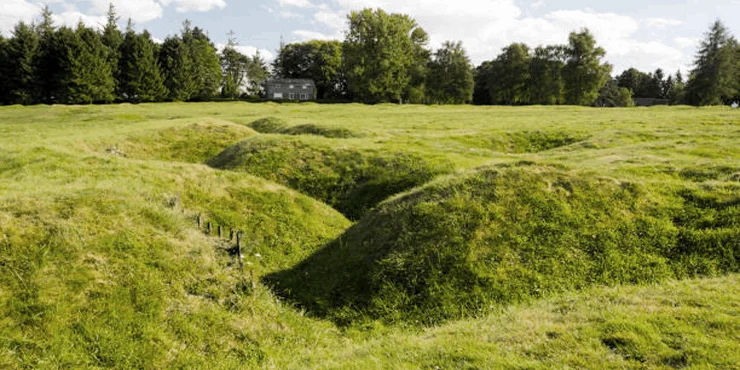Day One: The Ypres Salient and Last Post Ceremony at the Menin Gate
On day one we visit: —
Essex Farm Cemetery and Advanced Dressing Station — Essex Farm Cemetery contains some notable graves including a Victoria Cross winner and one of the youngest soldiers to be killed in the war. The nearby Advanced Dressing Station is famous due to John McCrae and the poem 'In Flanders Fields' which was written there. It is an excellent location to discuss the way in which casualties were handled during the First World War.
The French Memorial near Pilckem — This memorial commemorates the French 45th Algerian and 87th Territorial Divisions that were stationed along the northern edge of the Ypres Salient when the Germans mounted the first major gas attack on the Western Front on 22nd April 1915. It is an excellent location at which to discuss the use of Chemical weapons during the First World War.
The Welsh National Memorial — The Welsh National Memorial is dedicated to all Welsh men and women that were affected by the First World War. It commemorates the farmers, miners, railroad works, nurses, mothers and fathers who gave up their sons, in fact all Welsh men and women, and not just the soldiers that fought in the war. It is not, therefore, a memorial dedicated to the 38th (Welsh) Disivion that attacked up this ridge on 31st July 1917 at the beginning of the Third Battle of Ypres, also known as Passchendaele, but does provide an excellent spot at which to talk about the events of 31st July 1917, the first day of that great battle.
German Military Cemetery at Langemark — One of only four German Military Cemeteries in Flanders, Langemark contains the remains of some 44,000 German soldiers who fell during the fighting in the Ypres Salient. It is an ideal place to pause and consider the German fallen, and to pay our respects to them.
The Canadian Brooding Soldier Memorial — Located near Sint Juliann, the Canadian Brooding Soldier Memorial commemorates the First Contingent of the Canadian Expeditionary Force (which later became the Canadian 1st Division) that was in action on this spot over the period of 22nd to 24th April 1915. They held this position, which was on the left flank of the British Army, when the German Army launched the first ever large-scale gas attack against the French 45th Algerian and 87th Territorial Divisions who were on the left of the Canadians. It is an ideal spot at which to discuss the Second Battle of Ypres.
The 5th Australian Division Memorial, Buttes New British Cemetery and New Zealand Memorial to the Missing — The obelisk is similar in style to the other Australian Division memorials of the First World War including the one at Pozières on the Somme in France. It stands on the Butte of the pre First World War Belgium Army Rifle Range that in 1917 was the dominating ground within the area. At the base of the Butte, to the right as you enter, is the Buttes New British Cemetery and New Zealand Memorial to the Missing. The cemetery contains the graves of 2,103 soldiers, many of who were recovered some time after they had died. Only 428 of these are identified, which means that over three quarters of the burials are men 'Known Unto God'. Most of those buried here died in the Third Battle of Ypres. The Australian 5th Division memorial is an ideal place at which to continue discussions about the Third Battle of Ypres.
The New Zealand Memorial at 's Gravenstafel — The obelisk is similar in style to the other New Zealand First World War memorials including the one at Mesen (Messines). It honours the men of the New Zealand Division that fought here during the Battle of Broodseinde on 4th October 1917. It is an ideal place at which to continue the discussion of the Third Battle of Ypres, linking the Australian action at Polygon Wood with the final phase of the battle, the capture of the village of Passendaele.
The Canadian Memorial at Passendale — Passchendaele, or Passendale as it is now spelt, was the village that became the final focal point of the Third Battle of Ypres in 1917. It is the name by which the final stages of the Third Battle of Ypres is known, a name that has become synonymous with the blood, mud and horror of the First World War. It is a place that is ideal to discuss the climax of the Third Battle of Ypres in 1917.
Zonnebeke Memorial Museum Passchendaele 1917 Museum — With its reconstructed underground dugout and trenches this museum is an excellent place to discuss many aspects of the First World War and presents the historic story of the First World War in a poignant and vivid way. Its rooms provide an overview of the five Battles of Ypres using historical artifacts, letters, posters and other documents, as well as the uniforms of the various armies that fought in the Ypres Salient. The unique Dugout Experience allows the visitor to discover how the British went to live underground in 1917, an oppressive experience that creates a disconcerting picture of the miserable and claustrophobic living conditions at that time. The reconstructed German and British trenches in the Chateau grounds, along with their replicated shelters, give the visitor a vivid understanding of what trench warfare was like.
Tyne Cot CWGC Cemetery and Memorial — This is the largest Commonwealth War Graves Cemetery in the World. The name Tyne Cot, or Tyne Cottages, was the name given to a barn which stood near the level crossing on the Passchendaele-Broodseinde road by the Northumberland Fusiliers. That barn become the centre of five or six German blockhouses, or pill-boxes, that stood in the vicinity and were captured by the 3rd Australian Division on 4th October 1917 during the advance on Passchendaele. The cemetery contains the graves of 11,961 Commonwealth servicemen of the First World War, of which 8,373 are unidentified. The memorial forms the north-eastern boundary of the cemetery and commemorates nearly 35,000 servicemen from the United Kingdom and New Zealand who died in the Ypres Salient after 16th August 1917 and whose graves are not known.
The Last Post Ceremony at the Menin Gate — On the evening of your day spent touring the Ypres Salient you will have the opportunity to attend the world famous Last Post Ceremony at the Menin Gate at 8:00 pm. The Last Post Ceremony has become part of the daily life in Ieper (Ypres) and the local people are proud of this simple but moving tribute to the courage and self-sacrifice of those who fell in defence of their town. In 1928, a year after the inauguration of the Menin Gate Memorial, some of the more prominent citizens in Ieper decided that some way should be found to express the gratitude of the Belgian nation towards those who had died for its freedom and independence. Mr P Vandenbraambussche, the Superintendent of the Ieper Police, suggested the daily sounding of the Last Post - the traditional salute to the fallen warrior - at the Menin Gate Memorial, which standing as it does where the old city gate lead to the Ypres Salient battlefields and the Menin Road was, he believed, the most appropriate location. It was through the old city gate that so many British and Commonwealth troops had passed on their way to the Allied front line. From 11th November 1929 the Last Post has been sounded at the Menin Gate Memorial every night and in all weathers. The only exception to this was during the four years of the German occupation of Ypres from 20th May 1940 to 6th September 1944. Throughout this 'silent' period the daily ceremony was continued at Brookwood Military Cemetery, Surrey. On the very evening that Polish forces liberated Ypres the ceremony was resumed at the Menin Gate, in spite of the heavy fighting still going on in other parts of the town. This poignant and moving ceremony is one that the visitor should not miss.
Our day's touring complete, we head back to Arras and your tour hotel.



